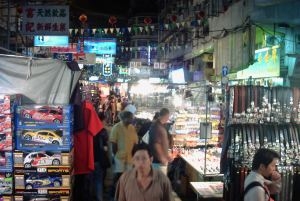
Retail sales in Hong Kong hold firm despite shaky financial environment
A 2% GDP is expected as trends in staple and luxury goods consumption revealed both high income and lower to middle income households have kept up their spending.
Tourists from China averaging over two million per month also boosted sales.
These results support the view that private spending contributed more to growth than net merchandise exports in Q1. Hong Kong's economy is expected to start making a gentle rebound from Q2 onwards after having bottomed in Q1.
Here's more from HSBC:
Hong Kong's retail sales growth continued to normalize gently from the dizzying heights reached in 2011. Robust job market conditions, continued wage growth, and sustained strong visitor inflows are all helping to prop up private consumption in the city, suggesting that first quarter's GDP result should print a healthy 2% y-o-y.
Facts
Hong Kong's March retail sales growth leapt to a solid pace of 17.3% y-o-y from 15.6% in February, well above both consensus and expectations of a 14% and 12.5% rise respectively. In real terms, they rose 13.4%, faster than the 8.9% and 7.5% expected by consensus and HSBC.
For the full first quarter, nominal retail sales growth cooled to 15.9% in 1Q12, from 23.3% in 4Q11. By volume, retails sales growth slowed to a pace of 10.7% from 16.4% previously.
Sequentially, real retail sales continued to normalize as expected, contracting by 0.9% 3m/3m in comparison to an expansion of 0.3% previously.
To make up for a sharp post-Chinese New Year 6.6% m-o-m contraction in February, nominal retail sales rebounded by a healthy 9.7% m-o-m in March. On the same basis, real sales rebounded by 9.5% compared to a negative 6.4% previously.
Real retail sales growth of consumer durables stood out, rising by 34.5% y-o-y. Retail Sales of 'clothing, footwear & allied products' grew by 11.2%, of department stores by 11.0% and of 'jewelery, watches/clocks, and valuable gifts' by 10.2%.
Implications
The impressive strength of both staple, e.g. supermarkets, and luxury retail items, e.g. electronics, watches, jewelery, hint at two trends.
First, it is not only the highest income earners but also lower to middle income households who have kept up their spending despite ongoing turbulence in the external trade and financial environment. Almost three years of uninterrupted wage growth has been central to this, in addition to the continued strength of employer demand. That the unemployment rate remains at 3.4%, just 0.2% shy of a four year record low, plays testimony to this. Furthermore, last year's introduction of a new minimum wage legislation likely helped to boost the spending power of the lowest income households, as has the easing of headline and food price inflation since January.
Second, given the continued robust inflows of tourists from China averaging well over two million per month, the strength of staples also suggests that Mainland tourists are not spending exclusively on luxury items only.
The result supports the view that private spending once again contributed more to growth than net merchandise exports in Q1, underpinned by resilient job market conditions and strong inbound visitor inflows. Real GDP is expected to have risen by 2.0% y-o-y last quarter, slightly slower than the 3.0% recorded in 4Q11.
Hong Kong's economy is expected to start making a gentle rebound from Q2 onwards after having bottomed in Q1. As the recovery consolidates in 2H12, inflation should once again resume its position as top risk for the economy, rather than growth.
Bottom line: the resilience of local job market conditions and easing inflationary pressures are both supporting retail sales and hence domestic demand in Hong Kong, as are the continued strong visitor inflows. Retail sales should complete their normalization process within a few months, before starting to firm back up in 3Q12 once turbulence in the global trade cycle and financial markets start to subside.
























 Advertise
Advertise






